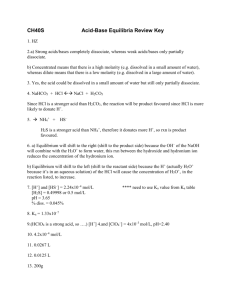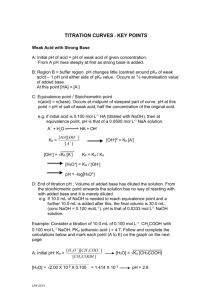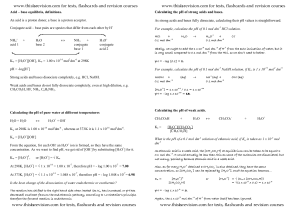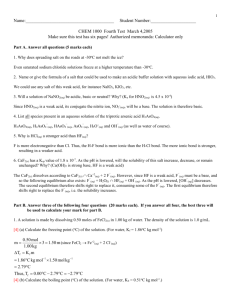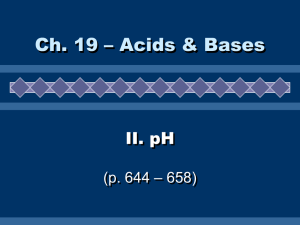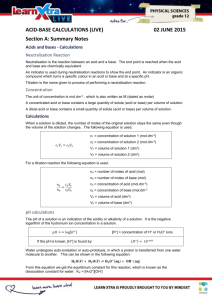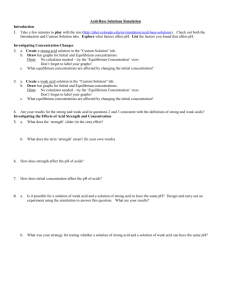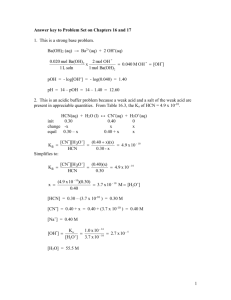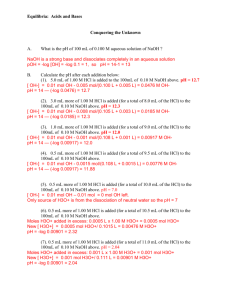Calculations in Chemistry
advertisement
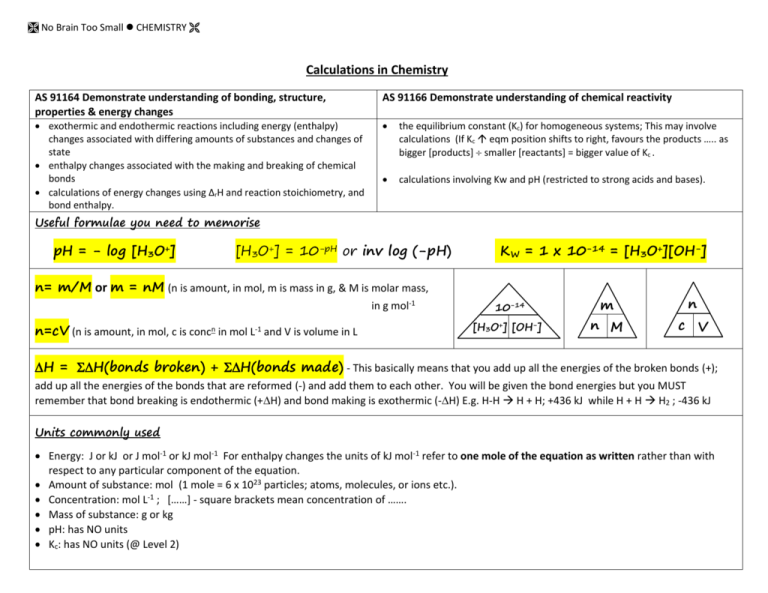
No Brain Too Small CHEMISTRY Calculations in Chemistry AS 91164 Demonstrate understanding of bonding, structure, properties & energy changes AS 91166 Demonstrate understanding of chemical reactivity exothermic and endothermic reactions including energy (enthalpy) changes associated with differing amounts of substances and changes of state enthalpy changes associated with the making and breaking of chemical bonds calculations of energy changes using ΔrH and reaction stoichiometry, and bond enthalpy. the equilibrium constant (Kc) for homogeneous systems; This may involve calculations (If Kc eqm position shifts to right, favours the products ….. as bigger [products] smaller [reactants] = bigger value of Kc . calculations involving Kw and pH (restricted to strong acids and bases). Useful formulae you need to memorise pH = - log [H3O+] [H3O+] = 10-pH or inv log (-pH) KW = 1 x 10-14 = [H3O+][OH-] n= m/M or m = nM (n is amount, in mol, m is mass in g, & M is molar mass, in g mol-1 n=cV (n is amount, in mol, c is concn in mol L-1 and V is volume in L 10-14 [H3O+] [OH-] m n M n c V H = H(bonds broken) + H(bonds made) - This basically means that you add up all the energies of the broken bonds (+); add up all the energies of the bonds that are reformed (-) and add them to each other. You will be given the bond energies but you MUST remember that bond breaking is endothermic (+H) and bond making is exothermic (-H) E.g. H-H H + H; +436 kJ while H + H H2 ; -436 kJ Units commonly used Energy: J or kJ or J mol-1 or kJ mol-1 For enthalpy changes the units of kJ mol-1 refer to one mole of the equation as written rather than with respect to any particular component of the equation. Amount of substance: mol (1 mole = 6 x 1023 particles; atoms, molecules, or ions etc.). Concentration: mol L-1 ; [……] - square brackets mean concentration of ……. Mass of substance: g or kg pH: has NO units Kc: has NO units (@ Level 2) No Brain Too Small CHEMISTRY 91164 Sample calculations The complete combustion of propane can be represented by the following equation CH3CH2CH3 + 5O2 3CO2 + 4H2O or we could redraw it to represent the bonds present: H Bond type C-H C-C O=O C=O O-H H H H C C C H H H H + 5O Average bond enthalpy kJ mol-1 413 347 498 805 464 O 3O C O + 4H O H Break Make 2x C-C 2x 347 6x C=O 6x -498 8x C-H 8x 413 8x O-H 8x -464 5x O=O 5x 498 = -8542 kJ Determine the [H3O+], [OH–] and pH in each of the following solutions. (a) 0.00112 mol L–1 HCl solution. (b) 3.68 × 10–2 mol L–1 NaOH solution. 2 values don’t need calculating at all……. HCl is a strong acid, reacts completely with water; HCl + H2O H3O+ + Cl- so [H3O+] = [HCl] NaOH is a strong base, dissolves completely in water; NaOH + aq Na+ + OH- so [OH–] = [NaOH] (a) (b) = 6488 kJ H = 6488 + - 8542 = -2054 kJ Remember “make” is exothermic so 91166 [H3O+] 0.00112 [H3O+] (a) pH 3.68 × 10–2 [OH–] – 0.00112 _ Calculate the amount of energy released when 25.0 grams of C4H10(l) is burned in oxygen using the equation provided. Method 1 2C4H10 (l) + 13O2 (g) → 8CO2 (g) + 10H2O (g); H = -5315 kJ 2 moles -5315 kJ 116* g -5315 kJ M(C4H10) = (4 x 12.0) + (10 x 1.00) 25g 25 x -5315 = 58.0 g mol-1. 116 So 2 mol has a mass of 116 g = -1145.5 kJ 1145.5 kJ of heat would be released. Method 2 2C4H10 (l) + 13O2 (g) → 8CO2 (g) + 10H2O (g); H = -5315 kJ M(C4H10) = 58.0 g mol-1 n(C4H10) = m/M = 25.0/58.0 = 0.431 mol If combustion of 2 mol of C4H10 releases 5315 kJ of energy, then the combustion of 0.431 mol of C4H10 releases (0.431/2) x 5315 = 1145.5 kJ (calculated keeping all numbers in calculator and rounding only final answer). [OH–] (b) [H3O+]= 10-14/[OH-] [H3O+]= 10-14/ 3.68 × 10–2 = 2.72 x 1013 -14 [OH ] = 10 /[H3O+] = 10-14/ 0.00112 = 8.93 x 10-12 3.68 × 10–2 pH pH = -log [H3O+] pH = -log 0.00112 = 2.95 pH = -log [H3O+] pH = -log = 12.6 Do a quick reality check… yes… an acid with pH of 2.95 and a base with pH of 12.6 sounds fine! Equilibrium constant (Kc) for homogeneous systems may involve calculations. e.g. For the reaction: H2(g) + I2(g) Ý 2HI(g) Kc = [HI]2 [H2][I2] A mixture of hydrogen and iodine was heated in a sealed flask at 491 oC and, at equilibrium, the concentration of hydrogen was 2.50 x 10-2 mol L-1, iodine was 2.50 x 10-2 mol L-1, and hydrogen iodide was 1.71 x 10-1 mol L-1. Calculate Kc. Kc = (1.71 x 10-1)2 = 46.8 (no units) -2 -2 (2.50 x 10 ) x (2.50 x 10 ) No Brain Too Small CHEMISTRY
